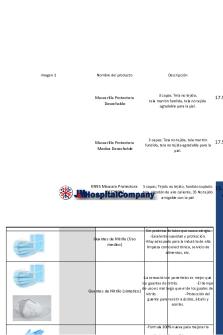Eating Disorders Brochure PDF

| Title | Eating Disorders Brochure |
|---|---|
| Course | General Psychology |
| Institution | Grand Canyon University |
| Pages | 3 |
| File Size | 275.7 KB |
| File Type | |
| Total Downloads | 45 |
| Total Views | 151 |
Summary
000000000000000000...
Description
WHAT ARE EATING
REFERENCES:
DISORDERS? Eating Disorders (ED) are illnesses that involve a person’s eating behavior. An ED causes a person to be obsessed with food and their own body weight (NIMH, 2016). The disorders can start by eating too much or not enough, and the obsession taking over one’s life leading to severe damaging and changes. There many different types of eating disorders. Three of the most common are Anorexia Nervosa, Bulimia Nervosa, and Binge-Eating Disorder (NIMH,2016). Anorexia Nervosa involves food restriction that causes extreme body changes. A person with anorexia will
“Eating Disorders.” National Institute of Mental Health, U.S. Department of Health and Human Services, 2016, www.nimh.nih.gov/health/topics/eatingdisorders/index.shtml. Grison, S., Heatherton, T., & Gazzaniga, M. (2016). Psychology in your life (2nd ed.). New York, NY: Norton Publishing. “Remove the Stigma and Welcome the Voices of Those Who Are Struggling.” National Eating Disorders Association, 4 June 2019, www.nationaleatingdisorders.org/blog/removestigma-and-welcome-voices-those-who-arestruggling.
have major fears of weight gain, and my see themselves much heavier than they are in reality (Grison & Gazzaniga, 2019). Bulimia is when a person binge-eats and then vomits after, exercise profusely, or take laxatives to offset the calories. Binge-eating is when a person repeatedly eats often throughout the day, eating much more than most people would (Grison & Gazzaniga, 2019). A person with Bingeeating disorder may eat alone due to embarrassment and their habit of overeating. Leaving them feeling guilty, depressed or disgusted about themselves (Grison & Gazzaniga, 2019).
EATING DISORDERS IN ADOLESCENT MALES
STIGMAS Only women are affected 25% of individuals with Anorexia Nervous are men (NIMH, 2016). 40% of individuals with Binge-Eating Disorder are male (NIMH, 2016). 40% of individuals with Bulimia Nervosa are male (NIMH, 2016)
Having an ED means being super thin When people think of eating disorders, they think its only anorexia or bulimia, and anorexia means super skinny. Many people of every shape and size can struggle with an eating disorder. Binge-Eating Disorder and overeating usually does not have a “thin” outcome (NIMH, 2016). EDs are a lifestyle choice Eating Disorders are serious mental illnesses, resulting in major health issues, are associated with socio-biological influences and are often fatal (NIMH, 2016)
RESOURCES
Help Hotline (text or call):1-800-931-2237
Crisis Text Line: Text NEDA to 741741
National Institution of Males with Eating Disorders (NAMED): http://www.namedinc.org
http://beyondhunger.org
Online Support Groups: https://www.eatingdisorderhope.com/information/r esources-for-anorexia-bulimia-and-binge-eatingdisorder
EATING DISORDERS IN ADOLECENT MALES One in three teens struggling with an ED is male. Binge-eating, anorexia and bulimia are just as common in boys as they girls. In the United States, 10 million boys will be affected in some point of their lives with an eating disorder. Boys face a double stigma when it comes to having an ED. Usually the boy will be characterized as gay or feminine. With ED studies only being done among females, it has led to a misconception of eating disorders in males (NEDA, 2019).
TREATMENTS Treatment is crucial for those with an eating disorder. The earlier the person gets help, the better. Often, an individual diagnosed with an eating disorder also will suffer from depression and/or anxiety (NIMH, 2016). Treatments can range from psychotherapy (individual, group or family), medications, nutritional counseling and medical care and monitoring (NIMH, 2016). Medications include antidepressants, antipsychotics, or mood stabilizers. Medical care includes intensive outpatient care, partial hospital care, residential, or inpatient care, depending on the needs and stability of the individual (NEDA, 2019). Types of psychotherapy include Acceptance and Commitment Therapy (ACT), Cognitive Behavioral Therapy (CBT), Cognitive Remediation Therapy (CRT), and Dialectical Behavior Therapy (DBT) (NEDA, 2019). Providers for treatment include dietitian, physician, psychiatrist and psychotherapist (NEDA, 2019)....
Similar Free PDFs

Eating Disorders Brochure
- 3 Pages

Eating disorders - essay
- 11 Pages

Ch. 8 Eating Disorders
- 4 Pages

Eating and Sleep disorders
- 9 Pages

Eating disorders and the skin
- 6 Pages

Ch 20- Eating Disorders
- 14 Pages

PSY 254 - Eating Disorders
- 3 Pages

Feeding and Eating Disorders
- 9 Pages

Ch 8 Eating and Sleep-Wake Disorders
- 11 Pages

Brochure
- 3 Pages

Portafolio - BROCHURE
- 2 Pages

Depression brochure
- 3 Pages
Popular Institutions
- Tinajero National High School - Annex
- Politeknik Caltex Riau
- Yokohama City University
- SGT University
- University of Al-Qadisiyah
- Divine Word College of Vigan
- Techniek College Rotterdam
- Universidade de Santiago
- Universiti Teknologi MARA Cawangan Johor Kampus Pasir Gudang
- Poltekkes Kemenkes Yogyakarta
- Baguio City National High School
- Colegio san marcos
- preparatoria uno
- Centro de Bachillerato Tecnológico Industrial y de Servicios No. 107
- Dalian Maritime University
- Quang Trung Secondary School
- Colegio Tecnológico en Informática
- Corporación Regional de Educación Superior
- Grupo CEDVA
- Dar Al Uloom University
- Centro de Estudios Preuniversitarios de la Universidad Nacional de Ingeniería
- 上智大学
- Aakash International School, Nuna Majara
- San Felipe Neri Catholic School
- Kang Chiao International School - New Taipei City
- Misamis Occidental National High School
- Institución Educativa Escuela Normal Juan Ladrilleros
- Kolehiyo ng Pantukan
- Batanes State College
- Instituto Continental
- Sekolah Menengah Kejuruan Kesehatan Kaltara (Tarakan)
- Colegio de La Inmaculada Concepcion - Cebu



